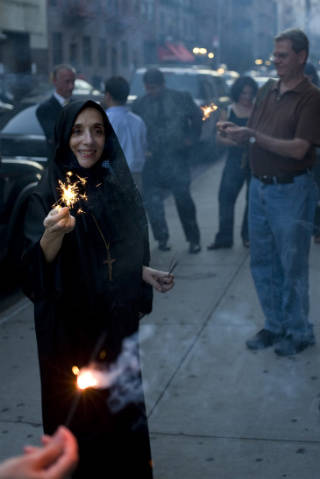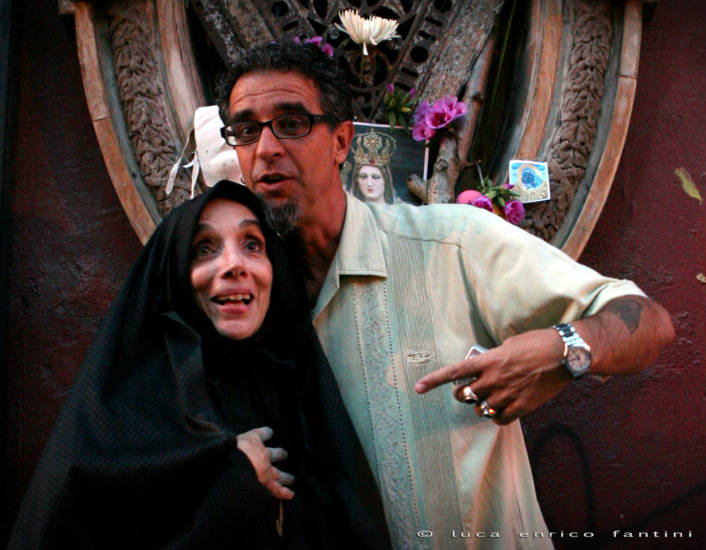What’s So Funny about the Virgin Mary?
Literary scholar and Queens College’s Distinguished Professor Fred Gardaphé has noted on numerous occasions that contemporary Italian Americans suffer from “irony deficiency,” especially as it concerns depictions of Italian Americans on big, small, and tiny screens.
The pungent and trenchant humor of folk witticisms, proverbs, and stories (think Giufà, the trickster fool) in local and regional languages have long ceased to be part of our everyday life. Farfariello (Eduardo Migliaccio), Nofrio (Giovanni DeRosalia), and other comic actors who used parody and comedy to aid immigrants navigate their way through a strange and estranging landscape are historical figures. In a similar vein, post-World War II comic performers like Lou Monte and Pat Cooper eased the transition of second- and third-generation Italian-Americans from ethnic slums to the white suburbs with their novelty songs and comic routines by bridging emic and etic perspectives.
In recent times, middle- and upper-class Italian Americans have been repeatedly taken to task for being humorless and downright choleric as they bemoan everything from the demise of the old neighborhood to Tony Soprano.
AH, COME ON! I’m just busting your balls and your ovaries. Can’t you take a joke?
I left the recent celebration of the Black Madonna in Manhattan with a better understanding of the changing nature of Italian-American humor and religion. This year’s event on September 8th made evident how perspicacious playfulness with Catholic objects, imagery, and ritual is re-energizing folks' understanding and enactment of that ever changing sensibility known as italianità. It was the ludic juxtaposition of what historian Robert Orsi calls “religious idioms” that contributed to the event’s dynamic artistry and acumen.
Recent interest in the Black Madonna among Italian Americans is predicated on the linkage between pagan earth goddesses and the Virgin Mary. What is intriguing about this revisionist reformulation is not necessarily its historical accuracy or its divergence with Catholic teachings but the exciting and often humorous ways New York Italians are recalibrating their ethnic identity to sync with their progressive religious and political beliefs.
The location of the five-year-old event is a gay bar that once housed a Sicilian chapel, an ironic convergence of Italian, Catholic, and homosexual topographies that can’t help but cause a wry smile. Performance artist LuLu LoLo (aka Lois Evans nee Pascale) walked into this hybrid space dressed as Saint Mother Cabrini. As her web site explains, Ms. LoLo “draws inspiration from her Italian heritage, movies, the circus, religious processions, and 99 cents stores.” LuLu’s campy minestrone is keeping with Cox's observation that “[j]uxtaposition celebrates the collision of symbol and situation as the occasion for new experience and unprecedented perception.” The sight of this petite artist dressed in a black habit chatting in a gay bar was hilarious.
Poet and performance artist Annie Lanzillotto and I emailed people encouraging them to bring objects to contribute to a collaborative altar we were proposing. After a few drinks, we moved outdoors where people began putting their objects within the building’s oval window frame to create a Manhattan wall shrine (edicole sacre). Author Tiziana Rinaldi and others attached a series of objects including a printout of a (white) Virgin Mary, flowers, and ribbons. In homage to the elders, Annie placed a Spaldeen rubber ball into the evolving shrine, along with a branch from a peach tree her grandmother Rose planted years ago. Literary scholar and poet George Guida brought a can of Chef Boyardee spaghetti and meatballs, a droll comment on the suburbanite, hyphenated childhood of many.
Evident on East 13th Street that night was “a tendency toward excess, a creative layering of objects that simultaneously evokes many relationships, many meanings – religious, familial, personal, political” that folklorist Kay Turner noted about women’s traditional domestic altars.
At one point, there was a call for “the baby.” Antonella – I didn’t catch her last name – handed off her infant Leonardo who was passed along the crowd and hoisted up to the makeshift shrine, lightheartedly echoing the blessing of children during feste, a gesture that both conferred power to the shrine and conveyed a blessing onto the child of that special night.
(from left to right: Annie Lanzillotto, George Guida, and the Fabulous LuLu LoLo and Leonardo.)
Attendants ranged from practicing Catholics and stone cold atheists. On the fifth year of our meeting, I was again reminded of scholar and author Mary Cappello's observations on religion in her memoir Night Bloom:
No matter with what conviction I tell myself that I have left the precepts of Catholicism behind--for they were more harmful than helpful to me--Catholicism still asserts itself as the bedrock, perhaps the major tableau vivant of my desiring, and Christianity's visage seems to mediate my most intimate relationships with other people, and even my my means of communicating with myself. It has left its indelible mark, and on some level I will never fully own the power and magic of its traces.
The evening’s good drink, conviviality, and artistic playfulness of religious symbols created a space where we all gathered beneath the protective mantel of the laughing Madonna Nera.




































i-Italy
Facebook
Google+
This work may not be reproduced, in whole or in part, without prior written permission.
Questo lavoro non può essere riprodotto, in tutto o in parte, senza permesso scritto.